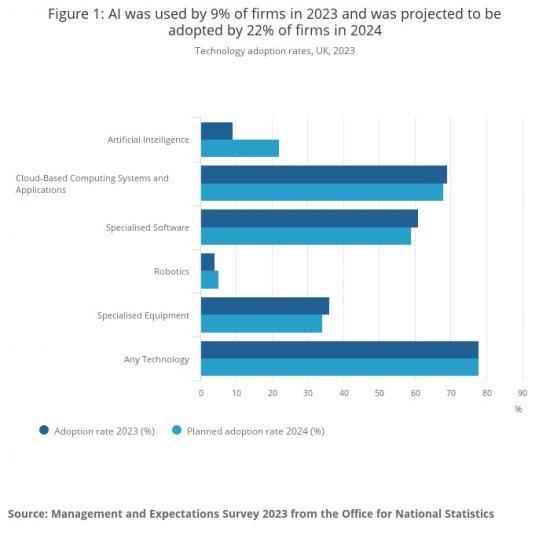Management practices and the adoption of technology and artificial intelligence in UK firms - 2023
26th March 2025

In 2023, artificial intelligence (AI) was adopted by 9% of firms while cloud-based computing systems and applications were adopted by 69% of firms in the UK.
While 88% of firms in the top decile of management practice scores adopted at least one of AI, cloud-based computing systems and applications, robotics, specialised software or specialised equipment, only 51% of firms in the bottom decile did so.
Large service sector firms were the most likely to adopt AI and large manufacturing firms were most likely to adopt robotics.
The most common barriers to AI adoption reported by firms in 2023 were difficulty identifying activities or business use cases (39%), cost (21%) and level of AI expertise and skills (16%).
Technology adopters were associated with 19% higher turnover per worker, after controlling for management practice scores and firm characteristics.
Firms with higher management practice scores were more likely to follow through in adopting AI in 2024, given that they planned to adopt AI in 2023.
The importance of technology and artificial intelligence adoption in UK firms
Understanding the adoption of technology and artificial intelligence (AI) in UK firms is crucial for understanding UK productivity and the increasing disparity in firm-level productivity, as noted in Office for National Statistics (ONS) research on business dynamism and productivity. One potential reason for this disparity is if the most productive firms are effectively using technology, but these advances are less likely to be adopted by less productive firms.
There is a keen interest in understanding the internal dynamics of firms, including the role of management practices as part of a firm's organisational capital - how they transform inputs into outputs and the strategies they use to enhance productivity. The marked disparity between the most and least productive firms underscores the need to understand the relationship between management practices and technology adoption.
This article investigates the ways in which technology adoption and AI vary with management practices in UK firms. Specifically, we address the following research questions:
How do management practices influence the adoption of technology and AI in UK firms?
What are the main factors driving AI adoption and the barriers faced by businesses?
What are the productivity outcomes and future plans for AI adoption in firms?
The ONS conducted the third wave of the Management and Expectations Survey (MES) between November 2023 and March 2024, sampling approximately 55,000 businesses. Inspired by the United States Management and Organisational Practices Survey (MOPS), the MES is one of the largest voluntary business surveys in the UK.
The MES evaluates business management practices by asking firms a series of structured questions on various management aspects, then assigning a score based on their responses. This survey introduced a new module on AI and Technology to explore the relationship between management practices, technology adoption and productivity. The module focuses on the adoption of AI, robotics, specialised equipment, specialised software, and cloud-based computing systems and applications.
The adoption of technology and artificial intelligence
This section presents technology adopters as firms that use an advanced technology as part of their methods or processes, so excludes firms that have tested advanced technologies but are yet to implement them.
In 2023, the adoption rate was high for cloud-based computing systems and applications, and specialised software (at 69% and 61%, respectively), moderate for specialised equipment (36%) and low for artificial intelligence (AI) and robotics (at 9% and 4%, respectively) (Figure 1). These adoption rates increase for all technologies when looked at by the share of employment, especially robotics and AI, as larger firms are more likely to adopt them. Adoption rates by share of employment are included in Table 1 of the accompanying dataset.
Figure 1 also compares the adoption rate in 2023 and planned adoption rates for the year ahead in 2024. This shows that AI adoption was projected to have increased from 9% in 2023 to 22% in 2024. However, there was less of a projected increase in adoption for the other technologies. Section 5 of this article provides more analysis of the future plans for technology adoption.
Read the full ONS article HERE
